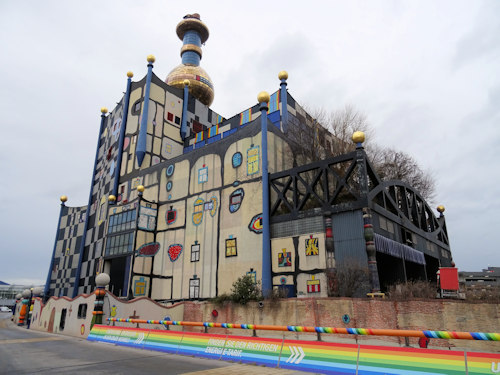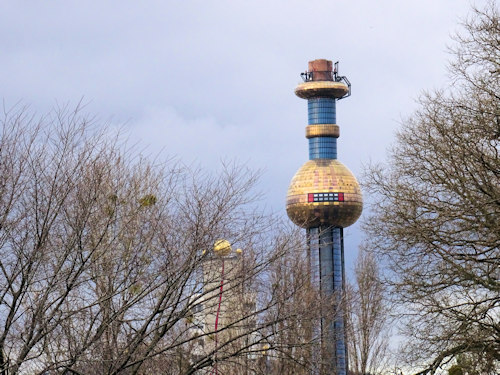
Municipal incinerators rarely top lists of architectural highlights. Ah, but this is Vienna, and they do things differently here. Consider, for example, the Spittelau incinerator with its remarkable design by Friedensreich Hundertwasser.
- 1960s building redesigned in the late 1980s
- Top features include the huge golden chimney ball, giant rooftop cap, and classic Hundertwasser façade
- Super photo opportunity & easily reached by public transport
- Award-winning sausage stand outside
- Book a guided city tour* in Vienna
- See also:
Hundertwasser’s masterpiece

(An unexpected look for a public utility))
If you saw the photo above, you’d probably assume some kind of contemporary art museum.
Nope.
This is one of Vienna’s municipal waste incinerators, producing energy for around 50,000 Viennese households (and heating and warm water for 60,000).

(Pigeons like it too)
The facility itself first went up in the late 1960s, but needed extensive repairs after a fire broke out in 1987.
That seemed an opportune moment to make something more of the incinerator, and the authorities eventually persuaded artist Friedensreich Hundertwasser to redesign the chimney and façade. All changes were completed by the early 1990s.
Although Hundertwasser might best be described as a painter, his architectural and design work has, perhaps, left the biggest impression on the public consciousness.

(The chimney viewed from an arm of the Danube)
The Spittelau incinerator now ranks as one of Vienna’s most striking landmarks, with the huge golden ball on its chimney an integral part of the cityscape. But it’s when you get up close that Hundertwasser’s architecture reveals its true majesty.
The styling, shapes, and colours echo the typical Hundertwasser approach you might know from the Hundertwasserhaus and Kunst Haus Wien, two of Vienna’s major tourist attractions.
The Kunst Haus Wien actually has a large model of the incinerator as part of its two-floor permanent exhibition of Hundertwasser artworks.

(A façade brimming with shapes and colours)
Enjoy, for example:
- A black and while variable tiling effect interspersed with coloured shapes
- The strong use of curves
- Live plants integrated into the design
- Multicoloured columns and other familiar Hundertwasser motifs
Pedestrian flyovers and access roads allow you to get excellent views of the façade. (Though not as good as the views the waste disposal truck drivers get: they even have their own Hundertwasser toilet facility, apparently.)

(A façade on a sunnier day)
Another curiosity is the large cap perched on the roof.
The story goes that Hundertwasser left one construction meeting with the words “Ich hau den Hut drauf.” The phrase means “I give up” but the literal translation is something like, “I throw a hat on top of it.”
The construction folk decided to take the idea and run with it.

(The golden chimney has become a city landmark)
Another bonus is the Wiener Würstelstand outside on Josef-Holaubek-Platz. Readers of the local Falstaff culinary lifestyle magazine voted it Vienna’s best sausage stand back in 2023.
Incidentally, the incinerator lies very close to the Donaukanal arm of the Danube.
Walk down to the riverside and south toward the city centre to almost immediately reach another remarkable piece of contemporary architecture: the housing block designed by Zaha Hadid.
How to find the incinerator
Many Viennese sights possess the happy knack of being located outside a subway station. And so it is with the incinerator.
Subway: The Spittelau station sits on the U6 and U4 lines.
Tram/bus: If you prefer to travel above ground, then catch the D tram to Spittelau from various tram stops on the central Ringstrassen (e.g. Schottentor or Karlsplatz/Oper).
Address: Spittelauer Lände 45, 1090 Vienna